Why Trust Gadgetbyte?
At Gadgetbyte, we invest substantial hours into rigorously testing each product or service we review, guaranteeing that you make informed purchases. Learn more about our testing process.
Review Overview
Display
9/10
Performance
9.5/10
Back Cameras
8/10
Front Camera
8/10
Software & UI
8.5/10
Battery
8/10
Speaker & Haptics
9.5/10
Value for Money
9/10
Design & Build
8.5/10
POCO F4 GT is an incredibly powerful phone with a bunch of gaming tricks up its sleeve. Besides, it also has a subtle design, a great display, quad speakers, and 120W fast charging. Yes—the F4 GT doesn't bring the best cameras or guaranteed software updates—but for those looking for a capable, no-nonsense gaming phone, this is an easy recommendation.
Gaming phones… yep, gaming phones have been a thing for some time now. While Apple and Samsung are yet to make a dent in this market, companies like POCO have found the biggest success in the gaming space itself. And here's our review of the POCO F4 GT, the company's latest gaming phone.
If you recall, POCO's very first phone—the POCO F1—was a roaring success among gamers and anyone else looking for the best performance per dollar. Plus, some of its newer releases like the X3 Pro, F3, and F3 GT were pretty decent gaming phones as well, despite a few shortcomings here and there.
And as expected from POCO, the F4 GT is the cheapest Snapdragon 8 Gen 1 powered phone outside of China right now, starting at just EUR 599 for the base 8/128GB model. There’s even a flat 100 euros off as an early bird discount. Amazing!
POCO F4 GT Specifications:
- Body: 76.7 x 162.5 x 8.5mm, 210 gm, Gorilla Glass Victus back, Aluminum frames
- Display: 6.67-inches AMOLED DotDisplay, 120Hz refresh rate, 480Hz touch sampling rate, Gorilla Glass Victus, HDR10+, 10-bit color depth
- Other Properties: 1920Hz high-frequency PWM dimming, DCI-P3 gamut, 800 nits (typ) brightness
- Resolution: FHD+ (2400 x 1080 pixels), 395 PPI, 20:9 aspect ratio
- Chipset: Qualcomm Snapdragon 8 Gen 1 5G (4nm mobile platform)
- CPU: Octa-core:– 1x Cortex-X2 (3.0 GHz)– 3x Cortex-A710 (2.50 GHz)– 4x Cortex-A510 (1.80 GHz)
- GPU: Adreno 730
- Memory: 8/12GB LPDDR5 RAM, 128/256GB UFS 3.1 storage (fixed)
- Software & UI: Android 12 with Xiaomi's MIUI 13 for POCO on top
- Rear Camera: Triple (with LED flash);– 64MP, f/1.9 Sony IMX686 sensor– 8MP, f/2.2 ultrawide sensor, 120° FoV– 2MP, f/2.4 portrait sensor
- Front Camera: 20MP, f/2.4 Sony IMX596 sensor (hole-punch cutout)
- Audio: Quad speaker, Dolby Atmos Audio, No 3.5mm headphone jack
- Security: Physical fingerprint sensor (side-mounted), Face unlock
- Sensors: Accelerometer, Ambient light, Color temperature, E-compass, Flicker, Gyro, Proximity, IR blaster
- Connectivity: Dual-SIM (Nano), WiFi 6E a/b/g/n/ac/ax (Dual-band), Bluetooth 5.2, GPS / AGPS / Glonass / Beidou / Galileo, USB Type-C, 4G LTE (VoLTE), 5G
- Battery: 4700mAh with 120W wired charging (120W power adapter provided)
- Color Options: Stealth Black, Knight Silver, Cyber Yellow
- What’s inside the box: POCO F4 GT, SIM ejector, 120W adapter, USB-A to L-shaped USB-C cable, USB-C to 3.5mm adapter, Protective case, User manual and other documents
- Price in Nepal: N/A (EUR 599 for 8/128GB | EUR 699 for 12/256GB)
POCO F4 GT Review:
Performance
- Octa-core Qualcomm Snapdragon 8 Gen 1 5G SoC (4nm)
- 8/12GB LPDDR5 RAM, 128/256GB UFS 3.1 storage (fixed)
- Android 12 with Xiaomi's MIUI 13 for POCO on top
So, like how last year’s POCO F3 GT was simply a rebranded Redmi phone, the F4 GT is yet another Redmi phone in disguise. More specifically, the Redmi K50 Gaming Edition. Considering Xiaomi’s insane rebrandings on budget phones, this is nothing really.
But I feel like maybe POCO could’ve delayed the launch of this phone by a couple of months for one reason and one reason only—Snapdragon 8 Gen 1.
As we already know by now, Qualcomm’s flagship processor for 2022 is quite toasty. Just take a look at this 20-thread CPU throttling test. The F4 GT throttles to 62% of its max performance which is pretty bad; but certainly not the worst we’ve seen. That honor goes to the Xiaomi 12 Pro for now.
Review Images
1/2
And the widely accepted cause for such disappointing performance has been low yields from Samsung’s 4nm node. Because of this, Qualcomm is reportedly switching to TSMC’s 4nm process with the upcoming Snapdragon 8 Gen 1+ for slightly better power efficiency and heat management as well.
Nice thermals
Anyway, I found that the upgraded LiquidCool 3.0 cooling solution here with a dual vapor chamber layer does keep the thermals in check.
POCO proudly highlighted that the F4 GT can handle a steady 120 fps for 2 hours straight in Mobile Legends Bang Bang. While our test pretty much confirms the company’s claims both in terms of fps throughput and temperatures, it’s worth noting that this is not exactly a resource-heavy game, to begin with.
And in other 120 fps-ready games like Critical Ops and Injustice 2, we experienced everything from frequent frame drops to straight-up performance throttling, where Critical Ops defaulted to just 60 fps after just 10 – 15 minutes into the game.
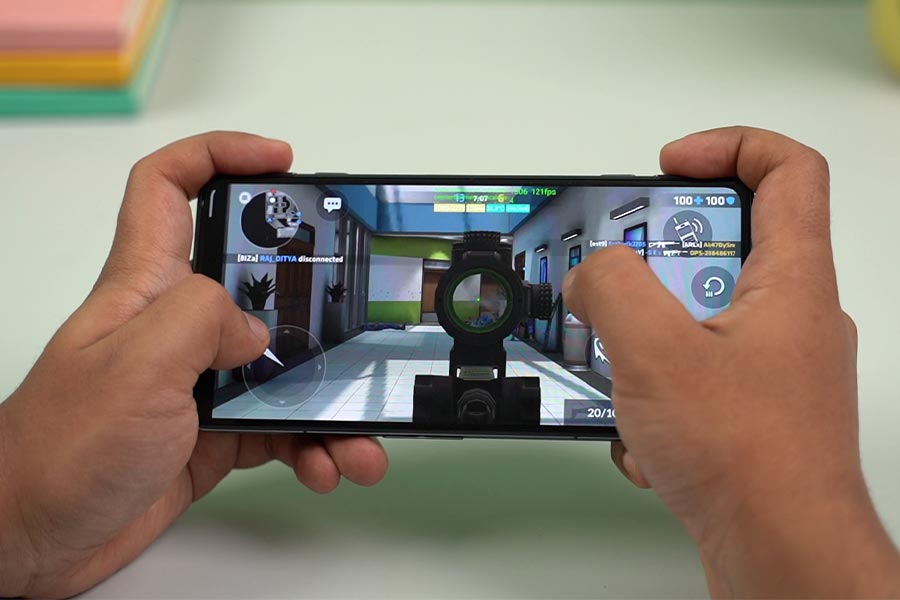
The F4 GT can apparently deliver stable 90 fps on Free Fire too. But we couldn’t find 90 fps mode here in the first place. Maybe it’s arriving with a future update in this part of the world. For now, you can enjoy the game at a smooth 60 fps under Ultra graphics profile. And the phone’s surface temperature stays at a comfortable 36 – 37°C range even after 30 – 40 minutes into the game.
Genshin Impact gameplay
Moreover, the F4 GT manages a fairly stable 50 – 60 fps on Genshin Impact at both High and Highest graphics presets for the first 10 – 12 minutes with negligible frame drops. But after 30 minutes into the game, I was netting about 41 fps on average where the phone’s temperature got quite hot too.
Apart from this, you can enjoy both PUBG and Call of Duty at 60 fps with 100% stability at the highest settings. The phone’s peak surface temperature stays below 41°C even after long gaming sessions which is pretty comfortable considering the ambient temperature on these Summer days. The POCO F4 GT can also handle all your old-school emulator games just fine.
Magnetic shoulder triggers
But what gives this gaming phone its name is without a doubt the physical shoulder triggers. You can customize its L and R buttons to set off any in-game control, and POCO's Game Turbo feature is intelligent enough to remember the button placement for each game.
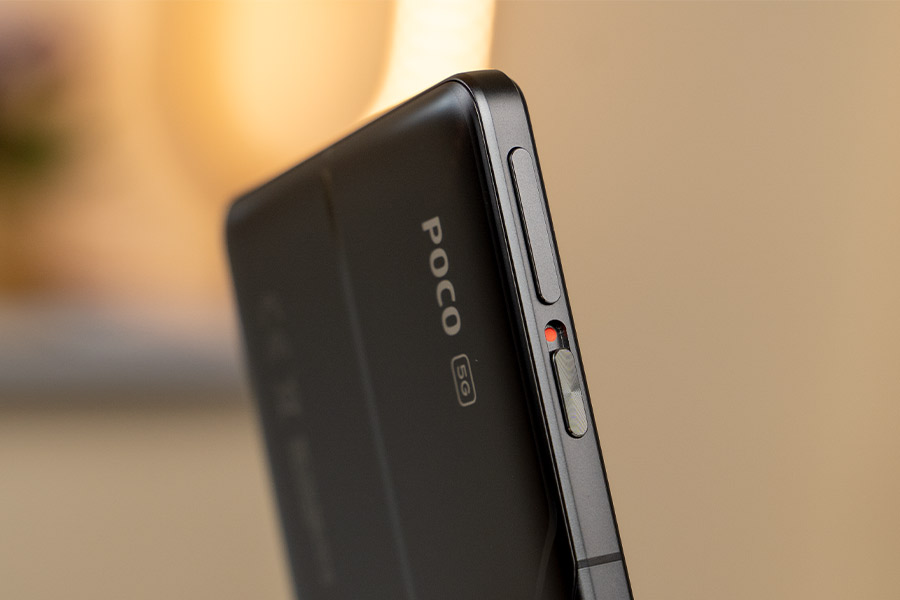
And while they are miles better over the virtual triggers you’ll find on Lenovo’s Legion Phone Duel 2 or the Asus ROG Phone 5, their tactile feedback certainly could’ve been a lot more premium.
How's regular performance then?
Besides gaming, the F4 GT’s everyday performance is pretty solid too. Yes, the Android 12-based MIUI 13 experience still isn’t as fluid compared to stock Android or One UI from Samsung, but at this point, I can live with it.
On the other hand, the 8 Gen 1 can handle everything you throw at it—be it opening large apps or multitasking between them. Stellar performance aside, POCO’s software commitment—or lack thereof—leaves a lot to be desired. There’s no official word on how many years of major OS and security patches the phone will receive.
Cameras
- Triple camera setup at the back
- (64MP main, 8MP ultrawide, 2MP macro)
- 20MP selfie camera (hole-punch cutout)
Review Images
1/2
Back
Anyway, great performance and terrible cameras pretty much go hand in hand on gaming phones but the F4 GT’s cameras honestly aren’t that bad. POCO has switched from Omnivision’s 64MP main sensor on the F3 GT to Sony IMX686 here, while the ultrawide and macro shooters remain the same as last year. The front camera has been upgraded to a 20MP Sony IMX596 sensor as well.
Normal Images
The regular daytime shots are a bit on the vibrant, punchier side—yes—but most of the time, they look quite alright. Under the right lighting conditions, you can expect nice photos with decent contrast and dynamic range as well.
Review Images
1/7
Yet, I wouldn’t exactly call it reliable enough since the F4 GT shoots wildly greenish/yellowish images at times. And it is also subject to color fringing sometimes.
Ultrawide Images
Review Images
1/4
Wideangle shots do switch to a noticeably cooler hue but they’re not that well-detailed and also suffer from bad exposure maintenance.
Portrait Images
Even portraits are a hit-or-miss here—well, mostly miss.
Review Images
1/5
POCO’s image processing usually paints the subjects with a jarring yellowish tint but under good lighting conditions, it can deliver decent photos.
Selfie Images
Review Images
1/4
When it comes to selfies, the F4 GT favors a smoothened skin tone despite all the beautification options turned off. Skin tones also look pale sometimes so I hope the company fixes all this with an update sometime soon.
Lowlight Images
Review Images
1/4
Moving on, its lowlight photos have similar color processing as the daytime shots. But since the phone lacks OIS, images do come off looking hazy sometimes.
Review Images
1/3
Having said that, turning on Night Mode gets you a lot nicer images with better HDR processing and noise control.
Videography
As for videos, the F4 GT maxes out at 4K 60 fps recordings. And even though there’s only electronic image stabilization on board, I’m really impressed to see pretty steady videos across all resolutions here. Unfortunately, there’s still no 4K recording from the front camera. And the dynamic range and exposure control on selfie videos aren’t that great either.
All in all, the POCO F4 GT still lags behind the competition like the Galaxy A73 in the camera department—especially in photos. But for a gaming phone with such an incredible value for money, there have to be compromises somewhere.
Design & Build
- 76.7 x 162.5 x 8.5mm, 210 grams
- Gorilla Glass Victus front/back, Aluminum frames
- No IP certification against dust and water damage
Okay, let’s now talk about the design in this review of the POCO F4 GT. For the most part, I feel like this could easily pass as a regular smartphone. Except for the Cyber Yellow color option, it doesn’t have that flashy, aggressive gamer aesthetics.
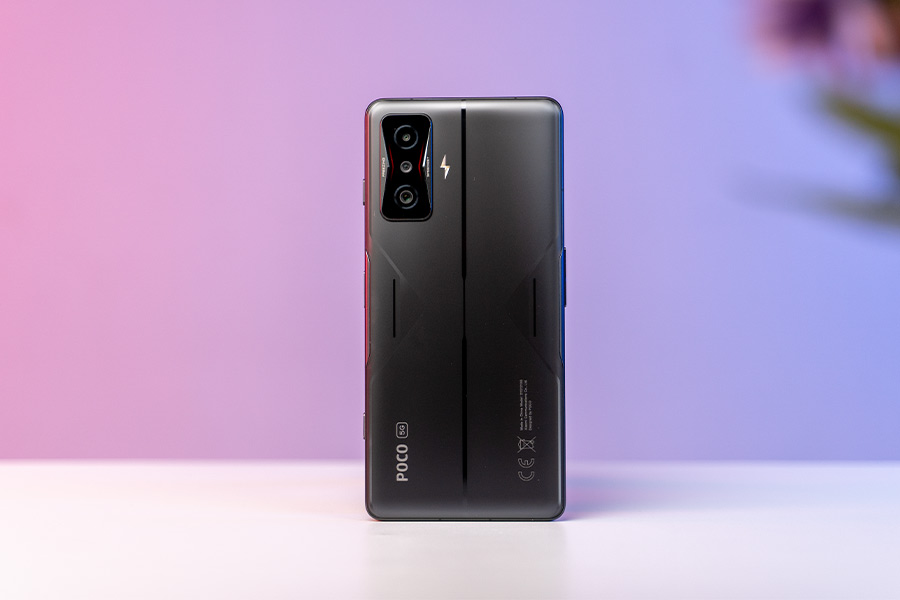
The one aspect where the F4 GT flaunts its gaming heritage the most is the camera module. It contains everything from a flash-shaped LED flash, some rather unnecessary brandings, and dual LED lights.
Funky notification lights
From app notification, charging status, to incoming calls, these notification lights do serve their purpose if you’re someone like me who mostly prefers laying the phone face down when not in use.
And its build quality is just as impressive! You’re getting Gorilla Glass Victus both on front and back this time besides the aluminum frames. They’re topped off with a matte finish as well so I haven’t had to deal with fingerprints and smudges quite as much here.
Review Images
1/4
Power button, Maglev Triggers
For a gaming phone, the F4 GT is naturally a bit bulky. But even though it weighs a whopping 210 grams, I didn’t really struggle handling it thanks to the decent weight distribution and heft. As for biometrics, POCO has once again gone with a side-mounted fingerprint reader which is incredibly fast and reliable. I guess my only complaint about this phone as far as design goes is that it lacks an IP53 rating like the F3 GT.
Display
- 6.67-inches FHD+ AMOLED (flat)
- 120/480Hz refresh/touch sampling rate
- 10-bit colors, 800 nits (typ) brightness
What’s next—yes, the display. The F3 GT basically has the same screen as its predecessor with a few upgrades here and there. You’re looking at a gorgeous 6.67” 1080p flat AMOLED panel to prevent any accidental touches or anything.
Other specs of this screen include a 120Hz refresh rate, up to 480Hz touch sampling rate, and 10-bit color depth. That means this display produces inky blacks and vibrant, punchy colors that look pleasing to the eyes. I’m quite fond of its factory color calibration as well but if you’d like to tinker with RGB levels, color temperature, and everything else, there’s that option too.
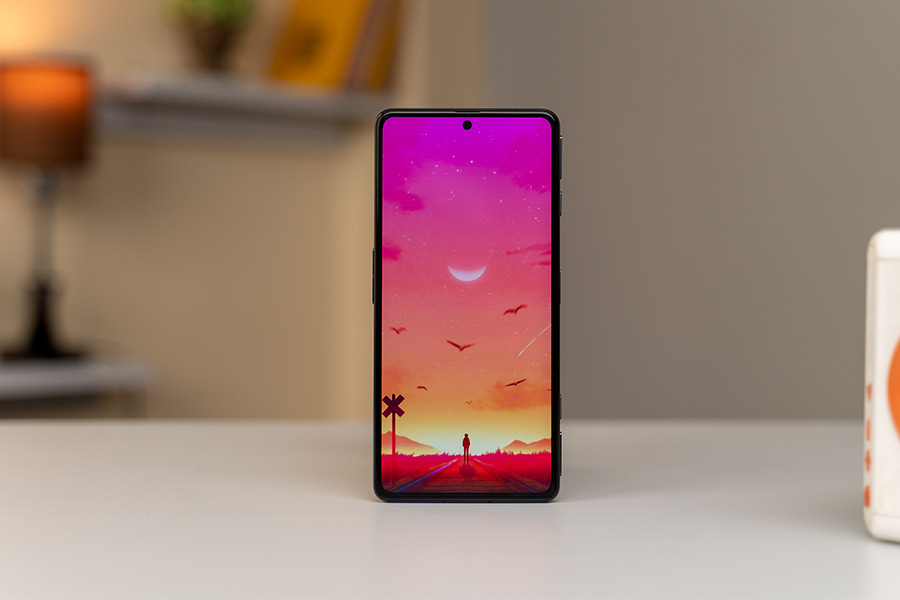
The POCO F4 GT also has excellent outdoor visibility and the auto-brightness feature works perfectly fine. Its viewing angle isn’t exactly bad, per se, but this screen is subject to a greenish color shift when looking at it from the sides.
Terrific phone for media consumption
POCO has also secured Widevine L1 and HDR10+ certification here so streaming HDR videos on this display is an absolute blast on YouTube and Netflix. On the other hand, the phone also implements dynamic refresh rate which means it can switch between 60 and 120Hz to save power.
However, I found that it’s not well optimized since the display sometimes stays at a steady 120Hz even when selecting the auto-refresh rate option.
Then again, you won’t find micro stutters or lags when scrolling through the phone’s UI like the company's budget or mid-range phones. And for all the night owls out there, this display has an incredible 1920Hz PWM dimming to prevent screen flickering when you’re sneakily gaming under the sheet or something.
Audio & Haptics
- Quad stereo speaker setup
- No 3.5mm headphone jack
- CyberEngine Super wideband X-axis linear motor
In terms of audio, the F4 GT boasts a quad-speaker system with support for Dolby Atmos and Hi-Res Audio. Apart from two driver units, the company has included two tweeters for crisp highs. Needless to say, its audio quality is quite pristine as it sounds full, balanced, and with excellent dynamic range.

Plus, it doesn’t distort at the highest volume as well. Still and all, I wish POCO brought back the 3.5mm headphone jack since this is a gaming phone after all. Yes, wireless earphones are much more convenient but they still can’t match the latency of wired headphones which is crucial for gamers.
Its haptics also deserves some praise as the vibration feedback from the x-axis motor is exactly the way I like it—strong and precise. Call quality leaves no room for complaint either although POCO is still using an inferior virtual proximity sensor here.
Battery
- 4700mAh battery with 120W fast charging
With that out of the way, it’s time to get into the battery section of this POCO F4 GT review. Despite the phone’s marginally thicker and heavier build quality, POCO has downsized the battery size from 5065mAh on the F3 GT to 4700mAh unit in a dual-cell design.
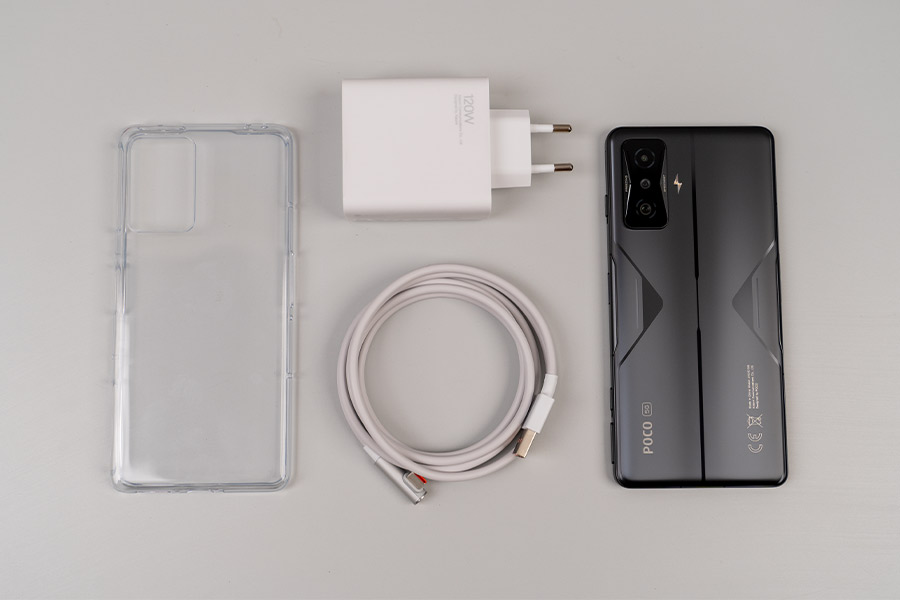
I don’t think this sacrifice is a result of the phone’s faster charging speeds because the Xiaomi 11T Pro which also supports 120W charging has a large 5000mAh cell. Instead, I believe this was necessary to accommodate the impressive cooling system I discussed earlier.
Sub-par battery life
Regardless, the F4 GT managed just about 5 – 6 hours of screen on time on average under moderate usage. Throw in longer gaming sessions into the mix then that number will drop by a couple of hours easily. Fueling up the phone is super fast though as it goes from 2 to 100% in just 17 minutes—or 27 minutes when you’re gaming—using the 120W charger.
Remember that I mentioned that this phone has a dual vapor chamber cooling system? Yeah, one of them is exclusively for the charging circuits in order to prevent overheating. Thanks to this, POCO says you can also game when pushing 120W power to the F4 GT but I don’t know… I’m kinda on the fence on this one.
POCO F4 GT Review: Conclusion
Wrapping up this review, the POCO F4 GT is yet another terrific gaming phone from the company. The performance upgrade here is BIG—I mean, the 8 Gen 1 is on a whole different level compared to the Dimensity 1200. But more importantly, the company has also installed quite an effective vapor chamber cooling solution which ensures great sustained performance over time.
And even though its cameras are still not on par with the competition, it has gotten considerably better which I think is mostly because of the Snapdragon chip’s superior image signal processor.
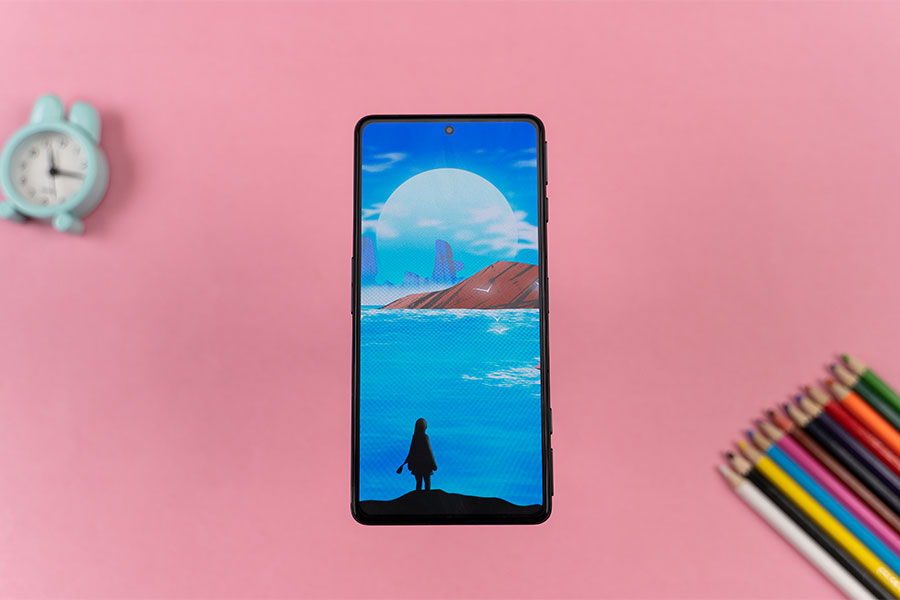
Moreover, its build quality, display, and speakers are really good too. So if you’re looking for a reliable gaming phone, I can easily recommend the POCO F4 GT to you. Yes, it has a few shortcomings like the cameras, better optimization for high fps games, and the lack of guaranteed software updates but that’s something you can overlook if pure bang for the buck is what you’re shopping for.
POCO F4 GT Review: Pros & Cons
Pros:- Great gaming experience
- Bunch of helpful gaming perks
- Premium build quality
- Smooth, vibrant AMOLED display
- Terrific speakers and haptics
- 120W fast charging
- No guaranteed software updates
- Skips an official IP rating
- No 3.5mm headphone jack
- Cameras could've been better
- Average battery life

To say something about myself, I have been writing tech and gadgets from 2021. Although coming from a non technical studies background, I'm someone who is always fascinated by the latest gadget and tech innovations, circling around. Besides writing, you'll find me listening music and aligning the stars through astrology and sometimes even, tarot cards! 😉🧿
Comments
No comments yet. Add a comment to start a discussion











































































